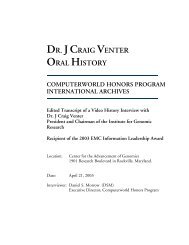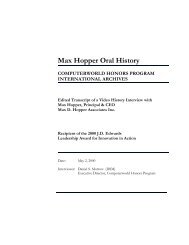NATHAN MYHRVOLD PhD ORAL HISTORY - The Computerworld ...
NATHAN MYHRVOLD PhD ORAL HISTORY - The Computerworld ...
NATHAN MYHRVOLD PhD ORAL HISTORY - The Computerworld ...
Create successful ePaper yourself
Turn your PDF publications into a flip-book with our unique Google optimized e-Paper software.
So the Sauropod dinosaurs were the largest and included Argentinasorus, which was<br />
the heaviest of all dinosaurs. <strong>The</strong> group my workers were most interested in is a<br />
group called the Diapsids, and includes Apotasaurus, Brontosaurus which is an older<br />
alias for Apatosaurus, Diplodocus, Berasaurus (ph.) which is the one in the American<br />
Museum of Natural History, rearing up on its’ hind legs in the rotunda.<br />
Those dinosaurs were enormously heavy, enormously long, at least 100 feet long<br />
many of them. <strong>The</strong>y had very long thin necks and very long thin tails. <strong>The</strong> tail<br />
would start off a meter in diameter and end up about this big around, and be 45 or so<br />
feet long. It was huge, so this huge long tail. What was it for? People had<br />
speculated a variety of things, that it was defense, that it would be used like a whip to<br />
hit something, or it was used for swimming. For a long time they felt they were<br />
aquatic. More recently they’ve discovered they lived in semi-arid areas. So it’s like<br />
the aquatic thing was just quite wrong. And the shape of the tail is so outlandish. It<br />
tapers down so. <strong>The</strong> last three-quarters of the tail I think weigh about five percent<br />
of the mass of the tail. All dinosaurs have a well-developed tail, but why after the<br />
normal size tail, why did it keep going? Most other Sauropod dinosaurs had 40 to 50<br />
colloidal vertebra, that’s a vertebra in the tail. <strong>The</strong>se would have like 80, and the<br />
vertebra at the end were very unusual. <strong>The</strong>y’re thin little bones with a cone at each<br />
end. So you’d have a cone joint, which would be enormously flexible. Why would<br />
you have a joint like this? Well Mcneil Alexander, the British biomechanics guy<br />
speculated that maybe they used their tails like a whip.<br />
So I sent an email to Phil saying this is one of the things we could check. And we<br />
decided we’d start with that. So he managed measurements of the tails of the<br />
dinosaurs from the literature, some things going back almost 100 years when they<br />
first discovered these dinosaurs, as well as more modern measurements. And I set<br />
out to model them in a computer. At first I thought I’d have to write my own<br />
program. <strong>The</strong>n I discovered that there was a package for Windows that was made<br />
for engineers and was used in product design and it would accurately simulate<br />
physics and friction and air resistance and all this stuff. So I could use a program that<br />
was calibrated by engineers on a daily basis. So the next thing I do is get a whip. I<br />
searched on the Internet under “bull whip,” and you get a very interesting, very<br />
diverse set of pages, you know. Someone watching this 100 years from now, the<br />
Internet may be different by then, but let me tell you, you get a very kinky set of<br />
pages on a bull whip. Not about dinosaurs at all.<br />
Nathan Myhrvold<br />
Oral History<br />
38









